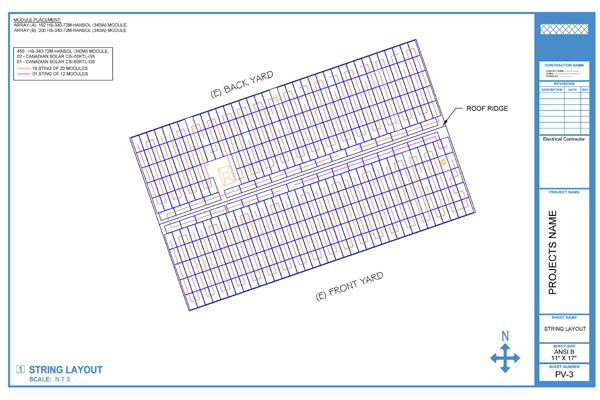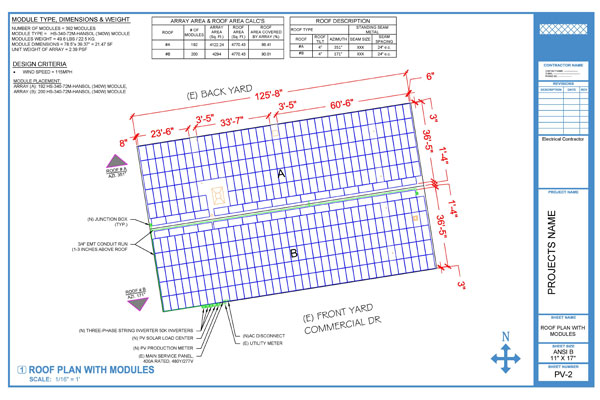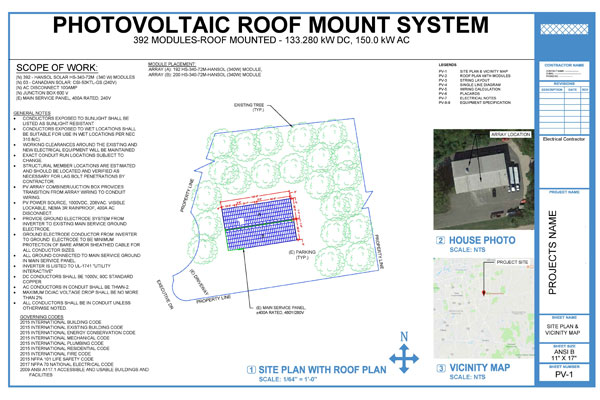Solar drafting services are an essential part of the solar power industry, from the moment the customer has an idea to the final installation. Solar drawings, aka “solar permit drawings” or “solar permit plans,” form an integral part of solar permits. (See below for more details on how such permit drawings fit into the solar permit process.)
Today, solar energy is emerging as a popular choice of renewable energy for residential housing, industrial buildings and commercial complexes. In fact, its an idea whose time has come: a simple, clean and renewable source of energy.
Now, solar panels with photovoltaic power systems convert sunlight directly into electricity. A solar mounting system can go either on the roof or ground (rooftop or ground-mounted). The mounting systems is a standard feature of any solar installation.
In short, a detailed solar panel layout plan serves as an essential tool for the construction and maintenance of solar arrays.
As a result, solar installation companies are major users CAD-based solar PV (photo voltaic) drafting services. Photovoltaic projects are a major driver of solar drafting services.
CAD, or computer-aided drafting, is the use of computers and software to replace manual cad drafting using drawing boards. Solar array layouts, detailed roof diagrams, residential roof mounts, commercial ground mounts, car-ports, and solar farms all require CAD drawings.
In fact, CAD-based solar drafting services includes a wide range of engineering disciplines, such as electrical, mechanical, structural, and architectural.
So, what are the benefits of CAD? Installers benefit greatly from the use of CAD because they can approach a project with an idea about how to lay out a solar array. Also, a key advantage of CAD is the ability to quickly measure the electric power output of a solar project.
Of course, to design an effective solar power system, the direction of the sun is an important consideration. Solar drafting services include the use of 3D shading analysis. This helps installers determine the correct positioning of solar panels.
Read more about how Design Presentation can help you.
Use our Get-A-Quote form to submit details about your solar project.
Before you install a solar power system, you’ll need to file for a permit to get approval for your project. Solar permits often require approval from two organizations— your local building authority (to approve new construction), the other from your local electric utility (to approve interconnection to the grid).
It takes time to submit detailed documentation for your solar panel system, like wiring schematics and spec sheets for each component.
Step 1: System Design & Line-Item Quote
First, you need to have a target system size and design in mind.
Step 2: Fill Out Interconnection Permit
Once you have a size and design in mind, you need to apply for an interconnection agreement, which gives you the approval to connect to the utility grid.
The utility company wants to ensure your system is safe and code compliant. To make that judgment, they’ll need to see component spec sheets and a wiring diagram to ensure everything is properly designed.
Interconnection agreements commonly ask for the following information:
1. Location of utility meter, electrical panel(s), proposed PV array and other landmarks.
2. The number of solar panels and inverters, including manufacturer and model being installed.
3. The capacity rating for your planned power inverter and PV panels.
Step 3: Building Permit
You’ll also need to file for a building permit with your local AHJ that oversees new construction—typically, your city planning office.
If you’re building a roof-mount system, the AHJ will want to confirm your roof is engineered to handle the extra weight of the solar array. Most recently built homes are fine, but older homes may have rooftops that are damaged and/or not engineered to support extra weight. In these cases, you could either replace/repair your roof or explore the possibility of ground-mount solar instead.
If you’re unsure, it’s a good idea to have your roof inspected by an engineer before filing for a building permit. Processing applications can take some time, and a rejected permit can delay your project for days or even weeks.
Step 4: Fill out & submit both forms
Once you have tracked down both forms, it’s time to fill them out and submit them. Gather the following info to have on hand during this process:
1. Product spec sheets
2. Site map / plot plan
3. Solar panel wiring diagrams
4. Fire safety ratings
5. Engineering certifications for panels and mounting hardware
6. PV labels and placard placement map
This process is fairly time-consuming, often resulting in applications around 10-15 pages long.



Leave a Reply